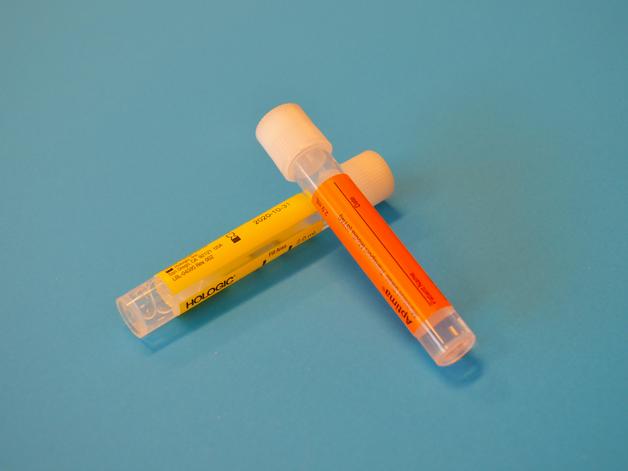You stare at the window, breath held, and there it is, a negative pregnancy test. Meanwhile your period is late, your breasts ache, and waves of nausea keep visiting. Confusing, right. Here is a calm plan, science first, then simple actions you can take today. You will see how the hormone hCG rises, why timing matters, how to read faint lines without second guessing, and when a blood draw brings fast clarity. Worried about an ectopic pregnancy or a chemical loss, or simply unsure whether to wait or test again, you will find a path forward.
How tests pick up a pregnancy
Pregnancy tests look for hCG, a hormone made by tissue that forms after the embryo attaches to the uterine lining. hCG appears in blood first, then in urine. In early pregnancy, hCG usually doubles every 37 to 48 hours, so a negative today can flip to positive two days later. That rise is biology, not a trick.
Implantation happens on average 8 to 10 days after fertilization, sometimes a bit earlier or later. If implantation is later in your cycle, hCG may be below detection on the day you test. That is why one test can be negative, then the next one finally shows what your body already suspected.
Urine tests vs blood tests
Home urine tests
Home sticks answer a yes or no question by detecting hCG in urine. Brands differ in sensitivity. Common thresholds sit near 20 to 25 mIU per mL, while some ultra sensitive options detect near 6 to 7 mIU per mL. That sounds early friendly, yet timing and urine concentration still rule the outcome. A test taken two days before a missed period can miss a very fresh pregnancy. For better odds, use concentrated urine and follow the reading window closely.
- One quick booster for success, try a first morning urine pregnancy test when urine is most concentrated.
- Keep an eye on the test sensitivity of pregnancy tests, lower numbers detect smaller amounts of hCG but still depend on cycle timing and urine dilution.
- Digital devices convert lines to words, that helps with reading, though they share the same biology and limits.
Blood tests
A quantitative hCG test measures the exact hCG concentration in blood. It helps when the urine result is negative but symptoms keep gathering, or when you need an early answer for treatment planning. Repeating the test about 48 hours later shows the trend, rising as expected, flattening, or falling. Numbers plus timing tell the story better than a single snapshot.
Urine and blood compared
Thinking about urine pregnancy test vs blood test choices, consider access, cost, and how fast you need clarity. Urine is great for home checkpoints. Blood gives numbers for timing, dating, and next steps like ultrasound.
What a negative result can mean
A negative read usually means no detectable hCG in the sample at that moment. Two situations fit that display.
- True negative, there is no pregnancy, and the test correctly found no hCG.
- False negative pregnancy test, a pregnancy exists, but hCG has not climbed high enough yet, or technique and timing got in the way.
A simple way to frame it, negative means no hCG detected right now, not a final verdict on what a repeat might show.
Faint lines, evaporation, and timing
A ghost of a line can spark hope or doubt. What then. Lines rely on both chemistry and timing. Read too early, the dye has not finished developing. Read too late, a pale evaporation line pregnancy test artifact can appear as urine dries. Use the time window on the box. If you are squinting at a whisper of a band, re test in 48 to 72 hours. That small wait often transforms a whisper into a clear message. Curious about faint line on pregnancy test meaning, it often signals very low hCG near the detection threshold, which is why the repeat matters.
When to test and how to avoid missteps
Testing too early is the number one pitfall. Aim for the day your period is due or the first missed day. If your cycles vary, add patience, because later ovulation pushes implantation and hCG rise later too.
Practical tips you can use today:
- Use first morning urine, higher concentration increases the chance of detection.
- Limit fluids for an hour before testing, dilution lowers the hCG signal.
- Check the expiry date and storage conditions, heat and humidity can impair the chemistry.
- Read inside the time window, usually a few minutes after dipping, and ignore late drying marks.
Still unsure after a negative pregnancy test, consider a blood draw. It is fast, precise, and helpful if symptoms are strong or if you are under fertility care.
Why a negative pregnancy test happens
Several explanations can overlap. Sorting them helps you choose the next move.
- Timing, hCG levels too low to detect at the moment of testing.
- Diluted urine, heavy hydration before testing lowers concentration.
- Device sensitivity, the brand threshold is higher than your current hCG.
- User error, dipping too long or too short, volume or angle issues, or reading outside the window.
- Misinterpretation, mistaking a drying artifact for a real line, or declaring negative before the chemistry finishes.
- Physiological events, very early chemical pregnancy with a brief rise then drop in hCG, a nonviable pregnancy, or an ectopic pregnancy that produces atypical hCG patterns.
- Medical context, polycystic ovary syndrome that shifts ovulation timing, thyroid disease, high prolactin, or medications that contain hCG used for fertility.
Symptoms present despite a negative test
Breast tenderness, nausea, fatigue, and a growing delay can clash with a negative pregnancy test. Why the mismatch. Two broad routes explain it.
- hCG is rising, but you tested before the best window.
- The symptoms come from another hormonal or functional cause.
Early pregnancy sensations overlap with other life factors. Stress, travel, sleep changes, an anovulatory cycle, and some medications can mimic early pregnancy. Breastfeeding can delay cycles. If symptoms intensify or the delay stretches beyond a week after a negative pregnancy test, a blood test is a smart next step. Facing a late period after negative test, that combination is common and often resolves with a repeat test two to three days later.
How common are false negatives and how to confirm
The chance of a missed pregnancy is higher before the missed period, then shrinks day by day. On the first missed day, studies suggest up to 10 to 20 percent of urine tests can miss a pregnancy. Technique matters, so does the brand. If you want to maximize pregnancy test accuracy, pair good timing with concentrated urine and careful reading.
Confirmation is straightforward:
- Get a blood hCG level today, then repeat in about 48 hours.
- In a healthy early pregnancy, the number usually rises by 60 percent or more in two days, sometimes doubling.
- If numbers plateau or rise very slowly, plan an ultrasound and close follow up to check location and viability.
Additional tests and useful thresholds
Key numbers that help frame decisions:
- Quantitative blood hCG
- Under 5 mIU per mL, usually not pregnant.
- From 5 to 25 mIU per mL, gray zone, repeat to see movement.
- Above 25 mIU per mL, the trend and timing matter more than the single value.
- Ultrasound timing
- Gestational sac often visible around 4.5 to 5 weeks counted from the last period.
- Yolk sac near 5.5 weeks.
- Cardiac activity near 6 weeks.
- When hCG is about 1500 to 2000 mIU per mL, a transvaginal scan usually sees an intrauterine sac if the pregnancy is in the uterus. If not, closer monitoring is needed to exclude an ectopic location.
When to think about an ectopic pregnancy
Some signs deserve fast attention. One sided pelvic pain, unusual bleeding, lightheadedness, shoulder tip pain, or worsening pain merit prompt evaluation even if you hold a negative pregnancy test or a faint positive. Ectopic pregnancies can produce slow rising hCG and no sac in the uterus at levels where one would be expected. Quick action limits complications and guides treatment, medical with methotrexate or surgical when needed, always tailored to symptoms and goals.
After a negative test, a step by step plan
You want a plan you can follow without second guessing. Here it is.
- If your period does not start, repeat a test in 48 to 72 hours, use concentrated urine.
- If still negative and symptoms persist, book a blood hCG and repeat it two days later.
- Check the box details, brand pregnancy test accuracy claims, and the sensitivity number.
- Review medications, fertility triggers that contain hCG can make a urine test positive for up to 10 to 14 days after the shot.
- Seek medical care for pain, bleeding, faintness, or if you feel unwell at any point.
Emotional impact and steady support
Hope and worry often sit together. You may ask, do I wait, do I act, what if I miss something. Short answer, set a simple date to retest or to draw blood, write it down, and breathe. Facts reduce the mental noise. Curiosity helps too, what is the pattern my body is showing. If anxiety keeps spiking, or if past experiences make this wait heavier, a conversation with a clinician can bring relief and a clear next step.
Common questions, quick answers
- Can I be pregnant after a negative pregnancy test, yes, especially if you tested early or used diluted urine. Repeat in 48 to 72 hours.
- Does a faint line count, usually yes, but confirm with another test because very light lines can be misread. Look up the faint line on pregnancy test meaning and use the time window.
- What if I am breastfeeding, ovulation can be delayed or irregular, which makes timing tricky. Use repeat testing and consider a blood test if you need a firm answer.
- Do stress or travel alter the result, they do not change hCG detection, but they can delay ovulation and your period, which shifts the best day to test.
Seo semantic boosters for parents
To help you search efficiently and find reliable information when facing a negative pregnancy test, here are terms that often answer parent questions. Use them thoughtfully and only as they fit your situation.
- negative pregnancy test for general queries and explanations
- false negative pregnancy test for timing and sensitivity issues
- hCG levels too low to detect to understand early timing limits
- urine pregnancy test vs blood test to compare home and lab options
- quantitative hCG test for number based follow up
- evaporation line pregnancy test to clarify confusing lines
- chemical pregnancy for very early loss explanations
- test sensitivity of pregnancy tests to choose a brand and time your test
- late period after negative test to plan retesting and blood work
- pregnancy test accuracy to improve technique and timing
Key takeaways
- A negative pregnancy test is a snapshot, not a final answer, especially if you tested early or used diluted urine.
- hCG rises quickly in early pregnancy, often doubling about every two days, so a repeat 48 to 72 hours later can change the result.
- Blood testing gives numbers that guide timing and ultrasound, which helps confirm, date, and locate a pregnancy.
- Red flags like one sided pelvic pain, bleeding, or faintness deserve prompt medical evaluation to rule out an ectopic pregnancy.
- You do not have to figure this out alone, clinicians and trusted resources can walk with you. For personalized tips and free child health questionnaires that make family life simpler, download the Heloa app, https://app.adjust.com/1g586ft8.
Throughout your decision making, keep your plan simple, repeat the test if the delay persists, and lean on clear information when the mind starts to race. A negative pregnancy test can flip to a clear path, either toward confirmation of a new pregnancy or toward answers for a late period that has another cause.
Questions Parents Ask
Can a pregnancy test be negative with twins or multiples?
Most often, multiples produce more hCG than a single pregnancy, so a false negative is less likely with twins. However, timing still matters. If implantation happened later than usual or the test was taken with very dilute urine, even a multiple pregnancy can be missed early on. If you suspect multiples (stronger symptoms, very rapid symptom increase, or fertility treatments), a blood hCG and an early ultrasound are the clearest ways to check.
Can medications affect pregnancy test results?
Some medications can interfere with results, but this is uncommon. The main example is an injection that contains hCG (used in some fertility treatments) — it can cause a false positive for days to a couple weeks after the shot. Most routine medications do not change whether a test detects hCG. What does matter is urine concentration: heavy fluid intake or some diuretics can dilute urine and make a test read negative when hCG is low. If you’re taking fertility drugs or any medicine you think could matter, mention it when you speak with a clinician or pharmacist; a quantitative blood hCG is often the fastest way to clarify.
How soon after ovulation can a test detect pregnancy?
Detection depends on implantation and how quickly hCG rises. Fertilisation happens within about a day of ovulation, but implantation typically follows 6–12 days later. Very sensitive blood tests can sometimes detect hCG a week after ovulation, while home urine tests are most reliable around the day your period is due — often about two weeks after ovulation in a regular cycle. If you test early and get a negative, waiting 48–72 hours and testing again usually gives a clearer answer.

Further reading :
- Home pregnancy tests: Can you trust the results? (https://www.mayoclinic.org/healthy-lifestyle/getting-pregnant/in-depth/home-pregnancy-tests/art-20047940)
- Home pregnancy tests: Can you trust the results? – Mayo Clinic (https://www.mayoclinic.org/healthy-lifestyle/getting-pregnant/in-depth/home-pregnancy-tests/art-20047940#:~:text=Could%20a%20negative%20result%20be,making%20HCG%20easier%20to%20find.)









